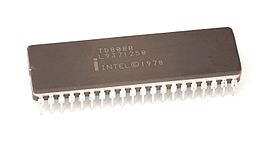8088

An Intel 8088 microprocessor
|
|
| Produced | From 1979 to 1990s |
|---|---|
| Max. CPU clock rate | 5 MHz to 10 MHz |
| Min. feature size | 3 μm |
| Instruction set | 8086 (16-bit x86) |
| Model | 8088 Series |
| Predecessor |
Intel 8080 Intel 8085 |
| Successor |
Intel 80188 Intel 80186 |
| Co-processor | Intel 8087 |
| Package(s) | |
The Intel 8088 ("eighty-eighty-eight", also called iAPX 88)microprocessor is a variant of the Intel 8086. Introduced on July 1, 1979, the 8088 had an 8-bit external data bus instead of the 16-bit bus of the 8086. The 16-bit registers and the one megabyte address range were unchanged, however. In fact, according to the Intel documentation, the 8086 and 8088 have the same execution unit (EU)—only the bus interface unit (BIU) is different. The original IBM PC was based on the 8088.
The 8088 was designed in Israel, at Intel's Haifa laboratory, as were a large number of Intel's processors. The 8088 was targeted at economical systems by allowing the use of an 8-bit data path and 8-bit support and peripheral chips; complex circuit boards were still fairly cumbersome and expensive when it was released. The prefetch queue of the 8088 was shortened to four bytes, from the 8086's six bytes, and the prefetch algorithm was slightly modified to adapt to the narrower bus. These modifications of the basic 8086 design were one of the first jobs assigned to Intel's then new design office and laboratory in Haifa, Israel.
Variants of the 8088 with more than 5 MHz maximum clock frequency include the 8088-2, which was fabricated using Intel's new enhanced nMOS process called HMOS and specified for a maximum frequency of 8 MHz. Later followed the 80C88, a fully static CHMOS design, which could operate with clock speeds from 0 to 8 MHz. There were also several other, more or less similar, variants from other manufacturers. For instance, the NEC V20 was a pin compatible and slightly faster (at the same clock frequency) variant of the 8088, designed and manufactured by NEC. Successive NEC 8088 compatible processors would run at up to 16 MHz. In 1984, Commodore International signed a deal to manufacture the 8088 for use in a licensed Dynalogic Hyperion clone, in a move that was regarded as signalling a major new direction for the company.
...
Wikipedia
